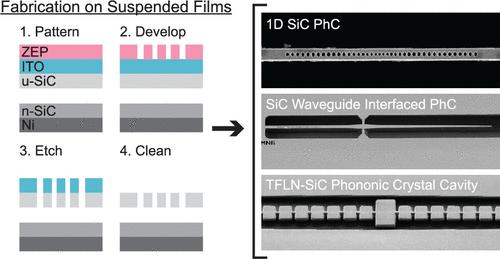A Suspended 4H-Silicon Carbide Membrane Platform for Defect Integration into Quantum Devices
IF 9.1
1区 材料科学
Q1 CHEMISTRY, MULTIDISCIPLINARY
引用次数: 0
Abstract
4H-silicon carbide is a promising platform for solid-state quantum technology due to its commercial availability as a wide bandgap semiconductor and ability to host numerous spin-active color centers. Integrating color centers into suspended nanodevices enhances defect control and readout, key advances needed to fully harness their potential. However, challenges in developing robust fabrication processes for 4H-SiC thin films, due to the material’s chemical and mechanical stability, limit their implementation in quantum applications. Here, we report on a new fabrication approach that first synthesizes suspended thin films from a monolithic platform and then patterns devices. With this technique, we fabricate and characterize structures tailored for defect integration, demonstrating 1D photonic crystal cavities, with and without waveguide interfaces, and lithium niobate on 4H-SiC acoustic cavities. This approach allows for greater fabrication flexibility, supporting high temperature annealing and heterogeneous material platform compatibility, providing a versatile platform for scalable fabrication of 4H-SiC devices for quantum technologies.

量子器件缺陷集成的悬浮4h -碳化硅膜平台
4h -碳化硅是固态量子技术的一个很有前途的平台,因为它作为一种宽带隙半导体的商业可用性和承载大量自旋活性色中心的能力。将颜色中心集成到悬浮纳米器件中可以增强缺陷控制和读出,这是充分利用其潜力所需要的关键进展。然而,由于材料的化学和机械稳定性,在开发坚固的4H-SiC薄膜制造工艺方面存在挑战,限制了它们在量子应用中的实现。在这里,我们报告了一种新的制造方法,首先从单片平台合成悬浮薄膜,然后图案器件。利用这种技术,我们制造并表征了为缺陷集成量身定制的结构,展示了具有和不具有波导界面的1D光子晶体腔,以及4H-SiC声腔上的铌酸锂。这种方法允许更大的制造灵活性,支持高温退火和异质材料平台兼容性,为量子技术的4H-SiC器件的可扩展制造提供了一个通用平台。
本文章由计算机程序翻译,如有差异,请以英文原文为准。
求助全文
约1分钟内获得全文
求助全文
来源期刊

Nano Letters
工程技术-材料科学:综合
CiteScore
16.80
自引率
2.80%
发文量
1182
审稿时长
1.4 months
期刊介绍:
Nano Letters serves as a dynamic platform for promptly disseminating original results in fundamental, applied, and emerging research across all facets of nanoscience and nanotechnology. A pivotal criterion for inclusion within Nano Letters is the convergence of at least two different areas or disciplines, ensuring a rich interdisciplinary scope. The journal is dedicated to fostering exploration in diverse areas, including:
- Experimental and theoretical findings on physical, chemical, and biological phenomena at the nanoscale
- Synthesis, characterization, and processing of organic, inorganic, polymer, and hybrid nanomaterials through physical, chemical, and biological methodologies
- Modeling and simulation of synthetic, assembly, and interaction processes
- Realization of integrated nanostructures and nano-engineered devices exhibiting advanced performance
- Applications of nanoscale materials in living and environmental systems
Nano Letters is committed to advancing and showcasing groundbreaking research that intersects various domains, fostering innovation and collaboration in the ever-evolving field of nanoscience and nanotechnology.
 求助内容:
求助内容: 应助结果提醒方式:
应助结果提醒方式:


